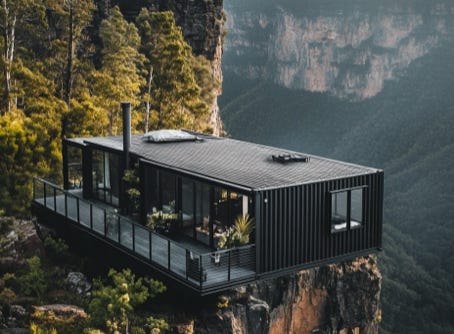professionalnobodies.net
HOME * ABOUT * PODCAST * AI NEWS * PRONOBIZ * UNDERSTANDING REALITY * CIRCUS SEC *
BALI MET * CREATIVE VACUUM * TINY HOUSES * BRAINQUAKES * VIDEO * GURU DETOX *

knights of the creative vacuum, work sphere for unbridled minds
Thinking Inside the Box: How Shipping Containers Are Revolutionising Tiny House Living
In an era where urban sprawl devours landscapes and housing prices soar, a growing movement is challenging traditional notions of home. It's time to rethink reality: there isn't unlimited space to be owned and occupied by a small group of individuals. Growing smaller is not just an option but a necessity in most Western societies, and houses are a good starting point to rethink our way of living.
The size of a home varies around the world; while some families live in one-room huts, others have gigantic homes that seem to never end. Homes tend to grow with their owner's prosperity. Since 1970, the size of the average new American home has grown by 50 percent—a growth trend mirrored in most Western countries. However, for every trend, there's a counter-trend. More and more people are choosing to live in small homes. Most downsizers opt for more modest quarters, while some take this trend to a new level, choosing to live in tiny homes (and we mean tiny)! These tiny homes can be as small as 90 sq. ft., complete with bedrooms, kitchens, bathrooms, and living quarters.
Enter the shipping container—a symbol of globalization now repurposed as a building block for sustainable, affordable, and innovative housing. The concept of tiny houses, especially those constructed from shipping containers, offers unlimited opportunities to live not only a more comfortable life but also offers a lot of freedom. Growing smaller does not have to mean less comfortable or less fun!
Shipping containers provide an ideal framework for these small shelters, from fixed homes to those on wheels and everything in between. All combinations are possible to develop: theme towns for artists, gamers, or musicians; tiny holiday resorts utilizing house-swapping; eco-towns with a farmer as the mayor. The adaptability of shipping container homes makes these ideas feasible.
The fun is you can take your tiny house on the road or ship it around the globe when you're in an adventurous mode. Imagine waking up in the Swiss Alps one month and relocating to a beach in Thailand the next—all without leaving the comfort of your own home. The modular design of shipping containers makes this nomadic lifestyle a reality.
Moreover, building with shipping containers is an eco-friendly choice. Repurposing these steel boxes reduces the demand for traditional building materials and gives new life to structures that would otherwise rust away in shipyards. It's a win-win for both homeowners and the planet.
As urban areas grapple with housing shortages and environmental concerns, container homes present a viable solution. They're quick to construct, customizable, and can be stacked or arranged in various configurations to maximise space in dense urban environments.
If you have great ideas, send them to info@professionalnobodies.net, and we will publish them with credits to you. The tiny house movement, bolstered by the innovative use of shipping containers, is more than a trend—it's a reimagining of how we live, interact with our environment, and define prosperity.












